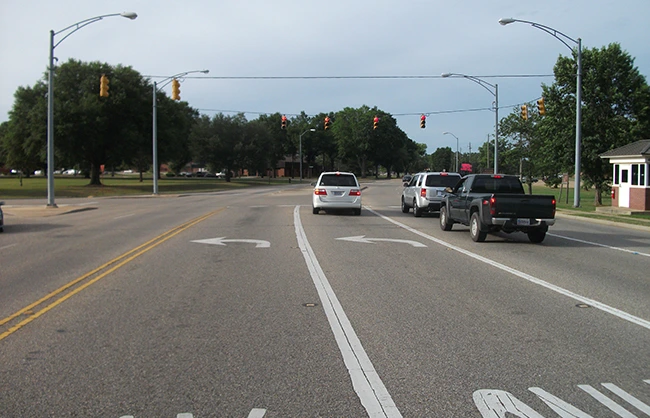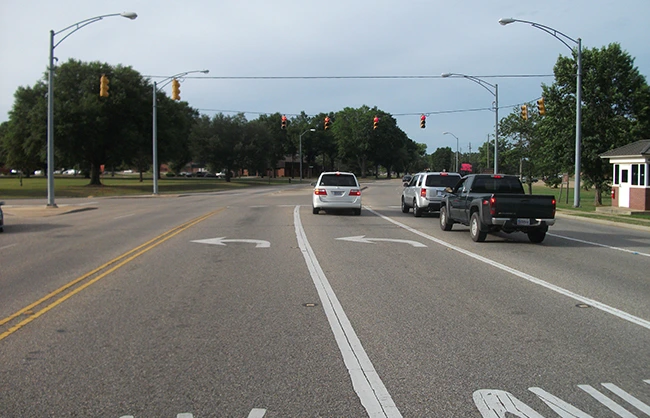Left-turn lanes are an integral part of intersection design and functionality and play an important role in improving traffic flow and safety.
The design includes factors such as lane width, entry and exit angles, and the overall geometry of the intersection to ensure optimal functionality and safety.
This report looks at the multifaceted aspects of left-turn lanes and examines their purpose, design considerations, impact on traffic dynamics, safety improvements and wider implications for urban planning and transport infrastructure.
Multifaceted aspects of left-turn lanes
Purpose and Design Aspects:
The main purpose of left turns is to separate turning traffic from through traffic, reduce congestion and improve the overall efficiency of intersections. These lanes are strategically designed to provide dedicated space for vehicles intending to turn left, reducing the likelihood of traffic bottlenecks and facilitating vehicle movement at busy intersections.
Impact on traffic dynamics:
Left-turn lanes have a significant impact on traffic dynamics at intersections. By creating a reserved space for left-turning vehicles, these lanes reduce disruption to through traffic. This separation of turning and passing movements promotes a more orderly and efficient intersection, reducing the likelihood of queues and congestion. The resulting improvement in traffic flow means saving time for drivers and reducing the number of delays.

Safety Improvements:
One of the main benefits of left-turn lanes is improving intersection safety. These lanes reduce conflicts between turning and through traffic, reducing the risk of collisions. Thanks to the spaces reserved for left turns, drivers have a clearer perspective and better visibility, which allows them to make more informed and safer decisions at intersections. In addition, the reduced likelihood of rear and side collision accidents further emphasizes the safety of well-designed left-hand lanes.
Traffic Signal Coordination: Optimizing Signal Phases for Efficient Turns
Integration of left-turn lanes often involves complex traffic signal coordination to optimize signal timing and phase. Traffic light controllers are programmed to designate specific time slots for vehicles making left turns to navigate the intersection efficiently. Synchronized signal functions help avoid conflicts between turning and overtaking, promoting the smooth and controlled movement of vehicles. Such coordination not only increases safety but also ensures a more predictable and organized traffic flow.
Challenges and Considerations: Balancing Spatial Constraints and Environmental Impacts
While left-turn lanes have many advantages, their implementation is not difficult. One primary aspect is the balance between the need for additional road space and consideration of potential environmental impacts. In urban areas with limited space, left-turn lanes may require compromises that require careful planning to minimize negative impacts on pedestrian access, green spaces or existing infrastructure.
Urban planning and transport infrastructure: Integration into the comprehensive road system
The presence and design of left-turn lanes are integral parts of wider urban planning and transport infrastructure strategies. Urban planners and traffic engineers must consider the optimal arrangement and design of these lanes in the context of the city and the total road network. Effective integration ensures that left-turn lanes contribute to a unified traffic system, minimize disruption and improve the overall efficiency of urban traffic.
Environmental Aspects: Sustainable Intersection Design
As the global focus on sustainable development increases, left-turn lanes are increasingly considered within the broader framework of environmentally conscious intersection design. Strategies such as integrating green infrastructure, promoting alternative modes of transport and optimizing traffic flow to reduce emissions contribute to a more sustainable approach to intersection design. Thoughtfully implemented left-turn lanes meet these principles, contributing to transportation systems that are both efficient and environmentally friendly.
Public awareness and education: Informing drivers about the use of the left turn lane
Ensuring the effectiveness of left lanes requires a parallel effort to promote public awareness and education. Drivers must be educated on the proper use of these lanes, including understanding when and how to merge into them and the importance of obeying signals and road signs. Educational initiatives promote safer driving practices and reduce the likelihood of confusion or mistakes at left-turn lane intersections.

Conclusion:
In summary, left-turn lanes are a key element in optimizing intersection efficiency. Designed to separate turning and overtaking, these lanes reduce congestion, increase safety and promote the overall smoothness of traffic flow. The integration of left-turn lanes into urban planning and transport infrastructure raises their importance as a strategic tool for managing the complexity of today’s road systems. As technology and sustainable practices continue to shape the future of transportation, left-turn lanes will continue to play a central role in creating safer, more efficient and environmentally conscious intersection
